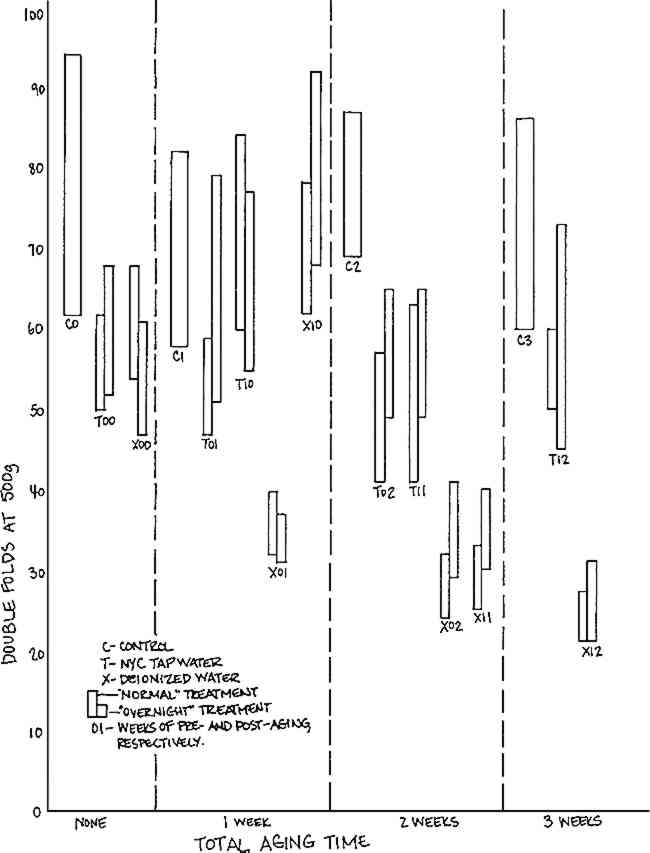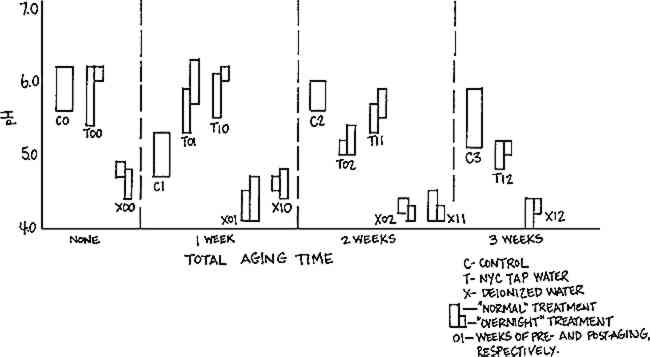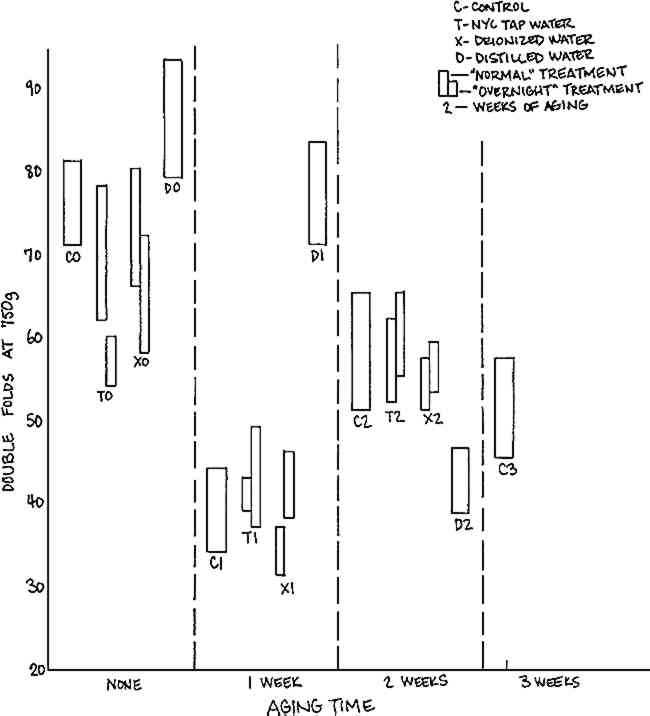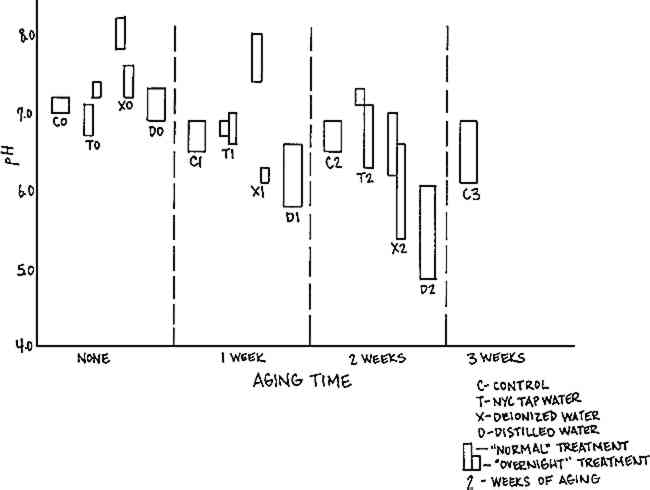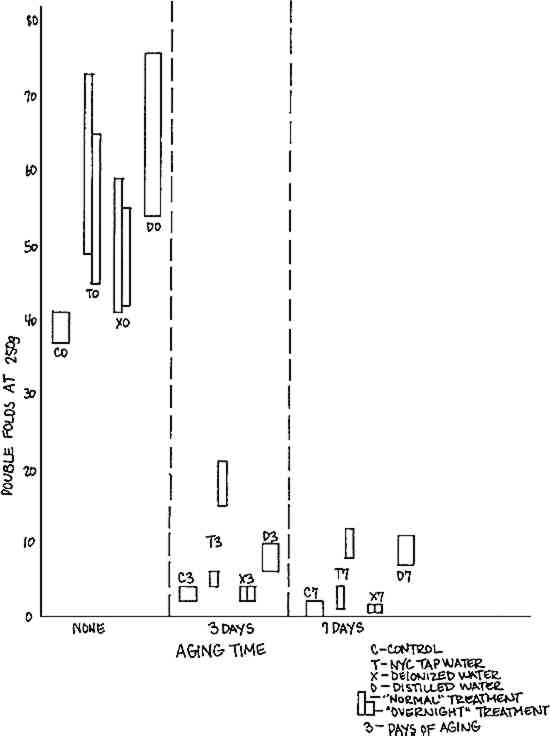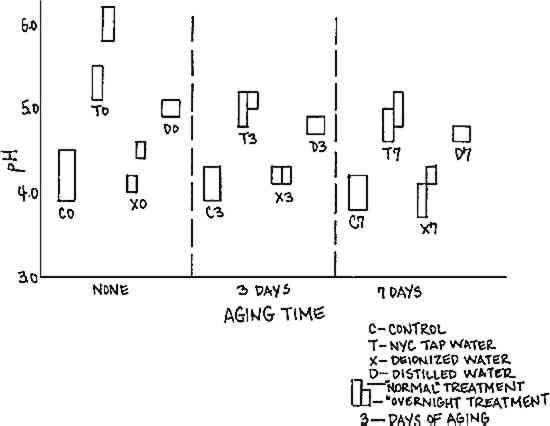EFFECTS OF WASH WATER QUALITY ON THE PHYSICAL PROPERTIES OF THREE PAPERSJ. Nelson, A. King, N. Indictor, & D. Cabelli
3 RESULTS3.1 Whatman Chromatography #1THE RESULTS OF TESTING CONTROLS and treated Whatman paper samples with various combinations of pre- and post-aging are summarized in Table II. Due to limitations on the size of the sample population, Whatman samples were washed in New York City tap water and deionized water only. (It proved to be an unfortunate choice to investigate differences in pre- and post-aging at the expense of the distilled water treatment, which was postulated to have an effect similar to that of deionized water. That pre-aging would have no effect and that there would be differences between the effects of distilled and deionized waters could not have been known before testing was completed and the data analyzed.) All samples were uniformly bright and exhibited no change in color, and negligible change in tensile strength, regardless of treatment. Changes were observed in folding endurance and pH. Table II. Effects of Wash Waters on Physical Properties of Whatman Chromatography #1 Paper Changes in folding endurance are represented in Figure 1. Values for the controls remain constant regardless of aging, indicating that oven aging alone had no effect. Values for the samples washed in tap water overlap the control values substantially; thus, no clear effect can be attributed to tap water washing. There is evidence of mechanical weakening from washing in deionized water with post-aging: all eight sample sets receiving this combination of treatment suffered approximately 50% loss of folding endurance. The four sample sets washed in deionized water without postaging had folding endurance comparable to the control and tap water washed samples. Pre-aging of samples made no perceptible difference in the response to washing and post-aging.
Results of pH testing, illustrated in Figure 2, indicate a drop in pH of all samples washed in deionized water, suggesting that an alkaline component of the Whatman paper is removed in washing with this purified water. This strongly suggests that the cause of the changes seen in folding endurance is associated with the washing, although only activated by the post-aging procedure.
3.2 Arches Cover InfinityThe results of testing controls and treated Arches Cover Infinity samples with various times of post-aging are summarized in Table III. There was no change in color, a slight decrease in brightness with aging regardless of washing treatment, and inconclusive changes in tensile strength. Again, changes were seen in folding endurance and pH. Table III. Effects of Wash Waters on Physical Properties of Arches Cover Infinity Paper Results of folding endurance are illustrated in Figure 3. There is a general downward trend with aging, with a significant drop in folding endurance for some samples aged one week. This drop and subsequent rise could be the result of a number of things, for example, possible cross-linking of a sizing agent which could compensate for deterioration due to aging.28
The values for folding endurance after distilled water washing do not follow the same pattern as those for the other treatments: there is a rise in folding endurance with one week oven aging which is difficult to explain. It is possible that the nitrogen in the water, or the lack of oxygen, had a relatively protective effect which was not dominant after more than one week oven aging, so that after two weeks aging, the samples Effects of washing on the pH of the Arches samples, illustrated in Figure 4, are not correlated with the effects on folding endurance. The pH is stable on aging regardless of treatment except for the samples washed for one half hour with deionized water and post-aged zero or one week. These show a slight increase in pH compared to the other samples. An explanation is suggested by the correlation of the increase in pH with the wash time. Short-term wetting with the deionized water could have resulted in an initially higher surface pH due to a concentration at the surface of an alkaline component of the paper, which would be either re-distributed in the paper or diffused into the wash water with the longer wash time.
3.3 Aquabee Newsprint Rough 887-RThe results of testing controls and treated samples of Newsprint with various times of post-aging are summarized in Table IV. There were inconclusive changes in tensile strength. Changes in color were dramatic and could be correlated with changes in reflectance. The trends, which were towards increased yellowing and decreased reflectance with aging of controls, were exacerbated by washing in deionized water, greatly inhibited by washing in tap water, and somewhat inhibited by washing in distilled water. Table IV. Effects of Wash Waters on Physical Properties of Aquabee Newsprint Rough 887-R Paper The precipitous decrease in folding endurance with aging is illustrated in Figure 5. All washing treatments without aging have a strengthening effect, which persists on aging only for the tap water and distilled water treatments. The protective effect of tap water washing on post-aged samples is apparent after the “normal” half-hour wash time, but is greatly increased with the increase in wash time to the “overnight”
Results of pH testing, illustrated in Figure 6, show a corresponding increase in pH for all samples washed in tap and distilled water. These results suggest the deposition in the paper during the wash treatment of some protective alkaline component of the tap and distilled water (which had pH 7.1-7.8), or alternatively, the removal from the paper during the wash treatment of some deleterious acidic component of the paper.
|
